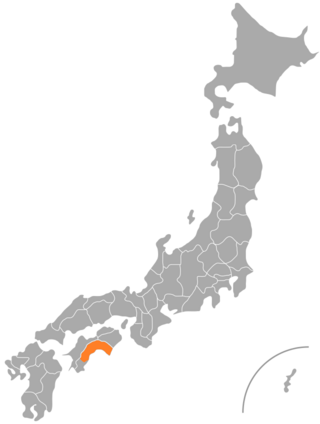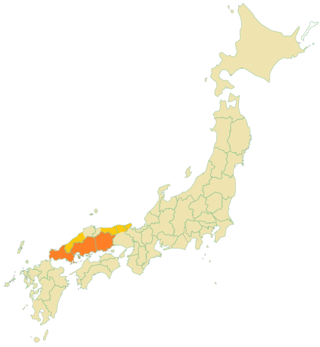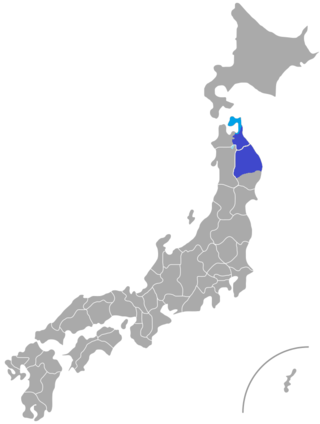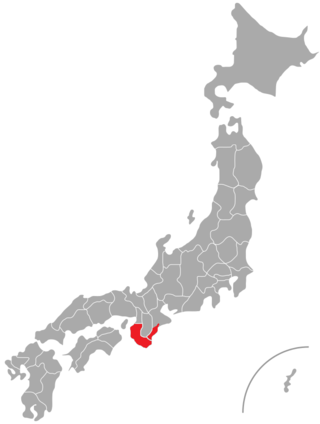
Hiroshima Prefecture is a prefecture of Japan located in the Chūgoku region of Honshu. Hiroshima Prefecture has a population of 2,811,410 and has a geographic area of 8,479 km². Hiroshima Prefecture borders Okayama Prefecture to the east, Tottori Prefecture to the northeast, Shimane Prefecture to the north, and Yamaguchi Prefecture to the southwest.
A mora is a basic timing unit in the phonology of some spoken languages, equal to or shorter than a syllable. For example, a short syllable such as ba consists of one mora (monomoraic), while a long syllable such as baa consists of two (bimoraic); extra-long syllables with three moras (trimoraic) are relatively rare. Such metrics are also referred to as syllable weight.

The Tosa dialect is a Japanese Shikoku dialect spoken in central and eastern Kochi Prefecture, including Kochi City. The dialect of the Western region of Kochi Prefecture is called the Hata dialect and is drastically different from the Central and Eastern dialect.

Fukuyama is a city in Hiroshima Prefecture, Japan. As of 31 March 2023, the city had an estimated population of 459,160 in 214259 households and a population density of 890 persons per km2. The total area of the city is 518.14 square kilometres (200.05 sq mi). After Hiroshima, it is the largest city in Hiroshima Prefecture. The city's symbol is the rose and it holds an annual Rose Festival in the month of May. The official mascot of Fukuyama is an anthropomorphic rose child by the name of Rola.

The Ibaraki dialect is a Japanese dialect spoken in Ibaraki Prefecture. It is noted for its distinctive use of the sentence-ending particles べ (be) and っぺ (ppe) and an atypical intonation pattern that rises in neutral statements and falls in questions. It is also noted for its merging of certain vowels, frequent consonant voicing, and a relatively fast rate of speech.

The Chūgoku dialect is a group of the Japanese dialects spoken in most of the Chūgoku region and in the northwestern Kansai region. It may be separated into two groups according to the form of the copula.

The Banshū dialect, also called the Harima dialect, is a Japanese dialect spoken in the Harima region of southwestern Hyōgo Prefecture. Although it is included in the Kansai dialect group, it shares much of its vocabulary with Chūgoku group. It can be further subdivided into the Western Banshū dialect and the Eastern Banshū dialect.

The Gunma dialect is a Japanese dialect spoken in Gunma Prefecture.

The Kanagawa dialect is the term used to describe the Japanese dialects spoken in Kanagawa Prefecture. As there is no single unified dialect throughout the prefecture, it is a collective term, with some of the regional dialects spoken including: the Sōshū dialect, the Yokohama dialect, the Hadano dialect and Shōnan dialect, among others.

The Shizuoka dialect is a Japanese dialect spoken in Shizuoka Prefecture. In a narrow sense, this can refer purely to the Central Shizuoka dialect, whilst a broader definition encompasses all Shizuoka dialects. This article will focus on all dialects found in the prefecture.

The Kaga dialect is a Japanese Hokuriku dialect spoken south of Kahoku in the Kaga region of Ishikawa Prefecture.

The Inshū dialect is a Japanese dialect spoken in the Inaba region of eastern Tottori Prefecture. It may also be called the Tottori dialect, though this is not to be confused with other dialects that are also spoken in the prefecture, namely the Kurayoshi and West Hōki dialects. It is considered an East San’in dialect of the wider Chūgoku dialect group. In parts of northern Hyōgo Prefecture that neighbour Tottori, specifically in the Tajima region, a similar dialect to the Inshu dialect is spoken. It bears many similarities to its close relative, the Kurayoshi dialect of central Tottori but retains some notable differences.

The Nanbudialect is a Japanese dialect spoken in an area corresponding to the former domains of Morioka and Hachinohe in northern Tohoku, governed by the Nanbu clan during the Edo period. It is classified as a Northern Tohoku dialect of the wider Tohoku dialect group.

The Narada dialect was a Japanese dialect spoken in the village of Narada, Hayakawa, located in Yamanashi Prefecture. Having formerly been isolated for centuries from surrounding areas, the dialect was considered a language island within the Tokai-Tosan dialect group, possessing various traits unique to Narada.

The Nairiku dialect is a Japanese dialect spoken in the eastern half of Yamagata Prefecture. It belongs to the Southern Tohoku dialect group.

The Chikuzen dialect is a Japanese dialect spoken in western Fukuoka Prefecture in an area corresponding to the former Chikuzen Province. It is classified as a Hichiku dialect of the wider Kyushu dialect of Japanese, although the eastern part of the accepted dialect area has more similarities with the Buzen dialect, and the Asakura District in the south bears a stronger resemblance to the Chikugo dialect. The Chikuzen dialect is considered the wider dialect to which the Hakata dialect, the Fukuoka dialect and the Munakata dialect belong.

The Nagasaki dialect is the name given to the dialect of Japanese spoken on the mainland part of Nagasaki Prefecture on the island of Kyushu. It is a major dialect of the wider Hichiku group of Kyushu Japanese, with similarities to the Chikuzen and Kumamoto dialects, among others. It is one of the better known Hichiku dialects within Japan, with various historical proverbs that relate to its regional flavour.

The Kishū dialect is a Kansai dialect of Japanese spoken in the former province of Kino, in what is now Wakayama Prefecture and southern Mie Prefecture. In Wakayama Prefecture the dialect may also be referred to as the Wakayama dialect.

The Okuyoshino dialect is a Kansai dialect of Japanese spoken in several villages in the Okuyoshino region of southern Nara Prefecture. It is well-known as a language island, with various rare and unique characteristics.


















